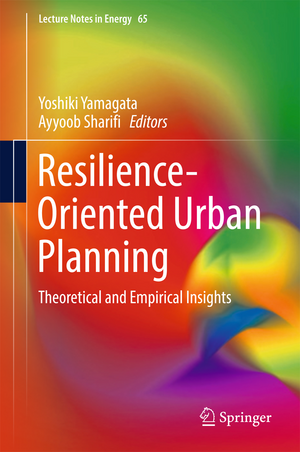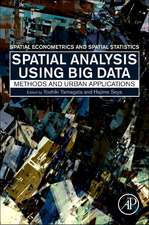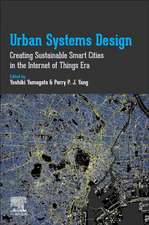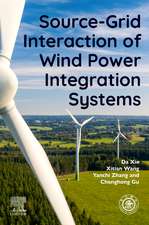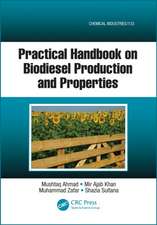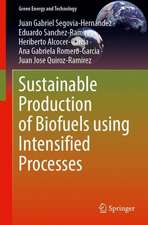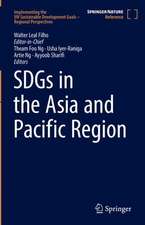Resilience-Oriented Urban Planning: Theoretical and Empirical Insights: Lecture Notes in Energy, cartea 65
Editat de Yoshiki Yamagata, Ayyoob Sharifien Limba Engleză Hardback – 21 feb 2018
Some of the main questions addressed are: What are the innovative methods and processes needed to incorporate resilience thinking into urban planning? What are the characteristics of a resilient urban form and what are the challenges associated with integrating them into urban development? Also, how can the resilience of cities be measured and what are the main constituents of an urban resilience assessment framework? In addition to addressing these crucial questions, the book features severalcase studies from around the world, investigating methodologies, challenges, and opportunities for mainstreaming climate resilience in the theory and practice of urban planning. Featuring contributions by prominent researchers from around the world, the book offers a valuable resource for students, academics and practitioners alike.
| Toate formatele și edițiile | Preț | Express |
|---|---|---|
| Paperback (1) | 694.04 lei 6-8 săpt. | |
| Springer International Publishing – 7 iun 2019 | 694.04 lei 6-8 săpt. | |
| Hardback (1) | 947.85 lei 6-8 săpt. | |
| Springer International Publishing – 21 feb 2018 | 947.85 lei 6-8 săpt. |
Din seria Lecture Notes in Energy
-
 Preț: 401.61 lei
Preț: 401.61 lei -
 Preț: 436.35 lei
Preț: 436.35 lei - 15%
 Preț: 655.60 lei
Preț: 655.60 lei - 18%
 Preț: 952.09 lei
Preț: 952.09 lei - 18%
 Preț: 1012.84 lei
Preț: 1012.84 lei - 15%
 Preț: 635.80 lei
Preț: 635.80 lei - 15%
 Preț: 645.96 lei
Preț: 645.96 lei - 15%
 Preț: 645.47 lei
Preț: 645.47 lei - 15%
 Preț: 640.06 lei
Preț: 640.06 lei - 15%
 Preț: 649.71 lei
Preț: 649.71 lei - 15%
 Preț: 643.84 lei
Preț: 643.84 lei - 18%
 Preț: 954.31 lei
Preț: 954.31 lei - 15%
 Preț: 643.84 lei
Preț: 643.84 lei - 18%
 Preț: 949.73 lei
Preț: 949.73 lei - 18%
 Preț: 1411.69 lei
Preț: 1411.69 lei - 15%
 Preț: 634.18 lei
Preț: 634.18 lei - 15%
 Preț: 649.87 lei
Preț: 649.87 lei - 15%
 Preț: 642.03 lei
Preț: 642.03 lei - 18%
 Preț: 957.62 lei
Preț: 957.62 lei - 15%
 Preț: 652.49 lei
Preț: 652.49 lei - 18%
 Preț: 963.15 lei
Preț: 963.15 lei -
 Preț: 361.03 lei
Preț: 361.03 lei -
 Preț: 391.79 lei
Preț: 391.79 lei - 15%
 Preț: 646.11 lei
Preț: 646.11 lei -
 Preț: 394.29 lei
Preț: 394.29 lei -
 Preț: 391.22 lei
Preț: 391.22 lei - 18%
 Preț: 954.45 lei
Preț: 954.45 lei - 18%
 Preț: 957.62 lei
Preț: 957.62 lei - 15%
 Preț: 647.27 lei
Preț: 647.27 lei - 18%
 Preț: 960.30 lei
Preț: 960.30 lei - 18%
 Preț: 1250.74 lei
Preț: 1250.74 lei - 15%
 Preț: 642.18 lei
Preț: 642.18 lei - 15%
 Preț: 639.41 lei
Preț: 639.41 lei -
 Preț: 488.71 lei
Preț: 488.71 lei
Preț: 947.85 lei
Preț vechi: 1155.91 lei
-18% Nou
Puncte Express: 1422
Preț estimativ în valută:
181.39€ • 196.97$ • 152.37£
181.39€ • 196.97$ • 152.37£
Carte tipărită la comandă
Livrare economică 22 aprilie-06 mai
Preluare comenzi: 021 569.72.76
Specificații
ISBN-13: 9783319757971
ISBN-10: 3319757970
Pagini: 345
Ilustrații: X, 228 p. 40 illus. in color.
Dimensiuni: 155 x 235 mm
Greutate: 0.51 kg
Ediția:1st ed. 2018
Editura: Springer International Publishing
Colecția Springer
Seria Lecture Notes in Energy
Locul publicării:Cham, Switzerland
ISBN-10: 3319757970
Pagini: 345
Ilustrații: X, 228 p. 40 illus. in color.
Dimensiuni: 155 x 235 mm
Greutate: 0.51 kg
Ediția:1st ed. 2018
Editura: Springer International Publishing
Colecția Springer
Seria Lecture Notes in Energy
Locul publicării:Cham, Switzerland
Cuprins
Section 1. Introduction, Ayyoob Sharifi and Yoshiki Yamagata.- Section 2. Planning and decision making process.- Section 3. Urban form and typologies.- Section 3. Resilience measurement methodologies.- Section 5. Case studies.- Section 5. Future directions, Yoshiki Yamagata Ayyoob Sharifi.
Notă biografică
Yoshiki Yamagata graduated from the University of Tokyo (PhD in System Science). Since 1991, he works at the National Institute for Environmental Studies (NIES, Tsukuba). Currently, he is studying about the climate risk management as Principal Researcher of Center for Global Environmental Research (CGER). He is also affiliated with IIASA (Vienna) and Institute of Statistical Mathematics (ISM, Tokyo). His recent research topics include: Land use scenarios, resilient urban planning and International regime networks. He has lecture series at the University of Tokyo, University of Tsukuba and Hokkaido University. Internationally, he has served as Lead author of IPCC, Steering committee of “Global Carbon Project” and Editorial board of “Applied Energy” etc.
Ayyoob Sharifi is a research associate at the Center for Global Environmental Research, National Institute for Environmental Studies and also one of the two Executive Directors of the Global Carbon Project (GCP), a Future Earth core project. As part of his duties as the executive director of the GCP, he is leading the urban flagship activity of the project which is focused on conducting cutting-edge research for supporting climate change mitigation and adaptation in cities. He holds a bachelor’s degree in Civil Engineering (Surveying), a master’s degree in Urban and Regional Planning, and a doctorate in Environmental Engineering. Ayyoob is interested in pursuing research at the interface of climate change and urban planning. The ultimate goal of his research is to provide further insights into how to develop sustainable and resilient urban communities. He is also interested in developing assessment tools that can be used as decision support systems at the local scale.
Ayyoob Sharifi is a research associate at the Center for Global Environmental Research, National Institute for Environmental Studies and also one of the two Executive Directors of the Global Carbon Project (GCP), a Future Earth core project. As part of his duties as the executive director of the GCP, he is leading the urban flagship activity of the project which is focused on conducting cutting-edge research for supporting climate change mitigation and adaptation in cities. He holds a bachelor’s degree in Civil Engineering (Surveying), a master’s degree in Urban and Regional Planning, and a doctorate in Environmental Engineering. Ayyoob is interested in pursuing research at the interface of climate change and urban planning. The ultimate goal of his research is to provide further insights into how to develop sustainable and resilient urban communities. He is also interested in developing assessment tools that can be used as decision support systems at the local scale.
Textul de pe ultima copertă
This book explores key theoretical and empirical issues related to the development and implementation of planning strategies that can provide guidance on the transition to climate-compatible and low-carbon urban development. It especially focuses on integrating resilience thinking into the urban planning process, and explains how such an integration can contribute to reflecting the dynamic properties of cities and coping with the uncertainties inherent in future climate change projections.
Some of the main questions addressed are: What are the innovative methods and processes needed to incorporate resilience thinking into urban planning? What are the characteristics of a resilient urban form and what are the challenges associated with integrating them into urban development? Also, how can the resilience of cities be measured and what are the main constituents of an urban resilience assessment framework? In addition to addressing these crucial questions, the book features severalcase studies from around the world, investigating methodologies, challenges, and opportunities for mainstreaming climate resilience in the theory and practice of urban planning. Featuring contributions by prominent researchers from around the world, the book offers a valuable resource for students, academics and practitioners alike.
Some of the main questions addressed are: What are the innovative methods and processes needed to incorporate resilience thinking into urban planning? What are the characteristics of a resilient urban form and what are the challenges associated with integrating them into urban development? Also, how can the resilience of cities be measured and what are the main constituents of an urban resilience assessment framework? In addition to addressing these crucial questions, the book features severalcase studies from around the world, investigating methodologies, challenges, and opportunities for mainstreaming climate resilience in the theory and practice of urban planning. Featuring contributions by prominent researchers from around the world, the book offers a valuable resource for students, academics and practitioners alike.
Caracteristici
Provides a range of innovative planning tools and methodologies Investigates urban form and its relation to urban resilience Presents various criteria and indicators for assessing the resilience of urban forms
